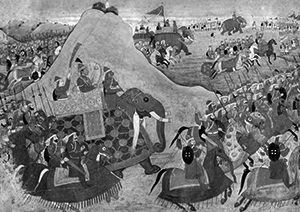The Age of the Vedas: Origin of the word ‘kshatriya’
It is said that the word ‘kshatriya’ comes from the root word ‘kshi.’ Even here, opinions differ. In Yaska’s Nirukta and in Panini’s Dhatupatha, the words ‘kshaatra’ and ‘kshatriya’ are shown to have been derived from the root 'क्षि' – 'क्षयैश्वर्ययोः.' From the semantic etymology of Nirukta, we have ‘क्षतात् त्रायते इति क्षत्रियः’ and when we consider the Dhatupatha, we learn that the origin is 'क्षि' – 'क्षयैश्वर्ययोः.' (One should not think that ‘kshaya’ refers to decay or drought.
The Amarakosha gives several meanings for the word ‘kshaya,’ including ‘place,’ ‘abode,’ ‘residence,’ and ‘refuge’). According to this definition, a kshatriya is one who gives refuge and helps the growth of prosperity. In addition, that root word has another meaning– ‘हिंसायाम्.’ This is related to the kshatriya’s duty of destroying the evil. Further, in the Manusmrti and other similar works, while suggesting surnames to people from different varnas, the name ‘varma’ is given to kshatriyas. The word ‘varma’ means ‘armor.’ What protects us, what saves us, has been called ‘varma.’ Just like an armor, ‘kshaatra’ is that which protects. And that is what we see in ‘kshaya’ (dwelling) as well. (In the Vedas it is common to see the word ‘kshaya’ being used to refer to ‘abode’ but it’s not common in the later texts, both literary and technical ones.)
The root word 'क्षि' has yet another meaning, ‘ऐश्वर्य’ – in the sense of bringing wealth and prosperity. What people need is wellness and peace. These arise from having an abode and resources. If a country has to prosper, first it needs internal and external security. Then it needs to develop its resources. If a country has good resources, its security strengthens. If a country is secure, there is a development of resources. These two are mutually dependent. If a country has a good economic standing, it is an obvious indicator that it has good security. A country that is unsafe can never become rich. In the Ayodhya Kanda of the Ramayana (Canto 67), several verses begin with ‘नाराजके जनपदे.’ Millennia ago, Valmiki spoke about all the perils that plague a country without a king [i.e. the dangers of anarchy]. We can see it even today. When the Lok Sabha elections are announced, when we see the rise or fall of the share markets, it becomes evident what kind of influence the elections have over the economy.
A country cannot progress if it faces a war from outside or troubles from within (our shastras speak of ‘षडीतयः’ – the six origins of a nation’s internal difficulties: from the king; from thieves and criminals; from disease; from insects, pests, worms, rats, and others; from excess rain or lack of rain; and from fire). Thus, the economy is a good indicator of a country’s progress.
With this background, we can appreciate Panini giving a meaning of ‘ऐश्वर्य’ to the root 'क्षि.' One of the fundamental characteristics of a kshatriya therefore is the development and protection of wealth. The two cannot be separate. When Krishna says “योगक्षेमं वहाम्यहम्” (Bhagavad-Gita 9.22), the words ‘yoga’ and ‘kshema’ are not joined by a dvandvasamasa; they are part of a single word, in singular; योगः अयमेव क्षेमश्च – yoga is indeed kshema. One feels like looking at it like a karmadharayasamasa; योगश्चासौ क्षेमश्च – that which is yoga and kshema. Yoga refers to the obtaining of something. “युजिर् योगे” suggests acquisition. Kshema refers to the retaining of what has been obtained. The characteristic of yoga-kshema is what we observe in 'क्षि' – 'क्षयैश्वर्ययोः.' In ‘kshaya’ (dwelling), we can observe kshema (wellness) and in ‘aishvarya’ (prosperity), we can observe yoga (acquisition).
The fundamental quality of the tradition of kshaatra is to maintain equilibrium. Sustenance is an important aspect of kshaatra. While the basic trait of a kshatriya might seem to be rajas, his/her स्थायिभाव (lasting state of mind) is sattva. Vishnu is generally considered the deity who maintains the cosmic order in the universe. While assigning the deities with a varna, Vishnu comes under the kshatriyas, as does his brother Indra, who is counted as a luminary among kshatriyas. As a matter of fact, in the Vedas, Vishnu, Indra, and all the adityas (the twelve sons of Aditi and Kashyapa) prominently exhibit traits of kshatriyas. A sattva-driven rajas is required for that. Rajas is the main quality of Brahma. Rajas is imperative for the purpose of creation. Sattva is the main quality of Vishnu. When it comes to kshaatra, sattva and rajas have to come together, with sattva driving rajas.
The moment we mention kshaatra-guna, there are pacifists who accuse it of promoting violence; they find it cruel and inhuman. But this stance of theirs is wrong. Without the element of protection, मात्स्यन्याय (big fish eat small fish) will prevail. There is an extensive discussion on this topic in the rajadharma prakarana in the Shanti Parva of the Mahabharata. What we should realize is this: if there has to be order, there has to be punishment; only if there is punishment, order will emerge. The Kamandakiya Nitisara proclaims, "One who accords (appropriate) punishments is a great soul," thus honoring the maintainers of law and order. That shows us the flavors underlying the fundamental characteristics of the word ‘kshatriya.’
Translated from the Kannada by Hari Ravikumar
(Translator’s notes in square brackets.)


















































